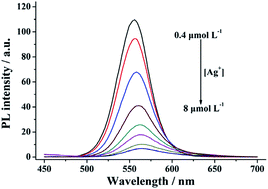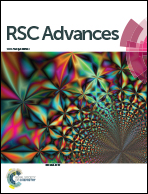Mercaptosuccinic acid modified CdTe quantum dots as a selective fluorescence sensor for Ag+ determination in aqueous solutions
Abstract
Water-soluble cadmium telluride quantum dots capped with mercaptosuccinic acid (MSA-CdTe QDs) were prepared for the selective and sensitive fluorescence probing of silver(I) ion. The fluorescence intensity of the MSA-CdTe QDs could be quenched only in the presence of Ag+, and the relative fluorescence intensity was decreased as a linear function of Ag+ concentration. Moreover, the proposed sensor was free from common interfering metal ions. The MSA-CdTe QDs were 3.0 nm in particle size and the maximum photoluminescence wavelength was 558 nm. Better sensitivity was obtained with 4.5 × 10−4 mol L−1 MSA-CdTe QDs in 200 mmol L−1 phosphate buffer (pH 9.0) for a reaction time of 30 min. A linear response between the relative fluorescence intensity, and the concentration of Ag+ was obtained over the range 0.4 to 8 μmol L−1, with a relative standard deviation of 3.6% (n = 5) for 1.5 μmol L−1 and a detection limit of 54 nmol L−1. The proposed method was applied for the determination of Ag+ in two fixer samples at the μmol L−1 level. The spike recovery at a spiked level of 15 μmol L−1 varying from 89.4% to 92.3%, and good agreement between the results by the proposed and AAS methods proved the accuracy of the proposed method.


 Please wait while we load your content...
Please wait while we load your content...